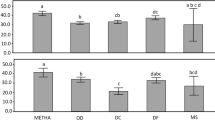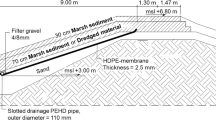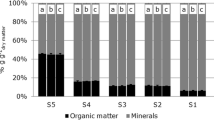Abstract
Purpose
The utilization of dredged material in dike construction as a substitute for traditionally used aged marsh sediment is considered an advisable option with respect to ecological as well as economic aspects. As a prerequisite to the application, the equivalency with respect to soil physical and mechanical properties of the materials has to be verified. Previous investigations on the compactibility of dredged materials used for dike construction had shown that the bulk densities of these materials were considerably lower than bulk densities of aged marsh sediments. The aim of the investigations presented in this paper was to analyze whether the compactibility of the processed dredged material could be improved by enhanced dewatering of the material prior to construction. It was hypothesized that a decreased water content of the material would allow higher bulk densities to be achieved during construction and hence the soil physical properties would become more comparable to those of the aged marsh sediments.
Materials and methods
To examine whether the compactibility of dredged material can be enhanced by pre-drying, Proctor tests were carried out at different initial water contents. Moreover, it was examined whether the temperature of oven-drying at 30 and 105 °C affects the compactibility of these materials and whether ripening, i.e., the repeated drying and wetting of the dredged material under natural and laboratory conditions, can improve their compactibility.
Results and discussion
The investigations on the effect of the various further processing methods showed that the compactibility and therefore the suitability of processed dredged material for dike construction can be improved by air-drying. A linear relationship between dehydration and Proctor density was found. Air-drying to water contents of 10% dry weight (DW) resulted in an improvement of the Proctor density of up to 11%. However, the tests on the effect of the drying temperature on the compactibility showed that oven-drying had no additional effect on the compactibility of the dredged materials. Ripening under laboratory and natural conditions did not lead to statistically significant changes in the compactibility of the processed dredged material either.
Conclusions
Air-drying of processed dredged material to water contents less than 10% DW is considered to be a useful pre-treatment option to improve the compaction behavior of processed dredged material and to obtain a better functional equivalency with traditionally used dike construction materials such as fine-grained aged marsh sediments.



Similar content being viewed by others
References
Aragón A, García MG, Filgueira RR, Pachepsky YA (2000) Maximum compactibility of argentine soils from the proctor test: the relationship with organic carbon and water content. Soil Till Res 56(3–4):197–204
Ball BC, Campbell DJ, Hunter EA (2000) Soil compactibility in relation to physical and organic properties at 156 sites in UK. Soil Till Res 57(1):83–91
Baumgartl T, Horn R (1991) Effect of aggregate stability on soil compaction. Soil Till Res 19(2–3):203–213
Berger K, Gröngröft A, Harms C (2011) Water balance and efficiency of landfill covers composed of layers of dredged material: results from long-term measurements in Northern Germany. Pedologist 54(3):285–293
Blanco-Canqui H, Shapiro CA, Wortmann CS, Drijber RA, Mamo M, Shaver TM, Ferguson RB (2013) Soil organic carbon: the value to soil properties. J Soil Water Conserv 68(5):129A–134A
Brils J, de Boer P, Mulder J, de Boer E (2014) Reuse of dredged material as a way to tackle societal challenges. J Soils Sediments 14(9):1638–1641
Cantré S, Saathoff F (2013) Investigation of dredged materials in combination with geosynthetics used in dike construction. Procedia Eng 57:213–221
Cantré S, Große AK, Neumannm R, Nitschke E, Henneberg M, Saathoff F (2013) Fine-grained organic dredged materials for dike cover layers—material characterisation and experimental results. In: XX World Dredging Congress and Exhibition 1-14
Chenu C, Le Bissonnais Y, Arrouays D (2000) Organic matter influence on clay wettability and soil aggregate stability. SSAJ 64(4):1479–1486
Denef K, Six J, Bossuyt H, Frey SD, Elliott ET, Merckx R, Paustian K (2001) Influence of dry–wet cycles on the interrelationship between aggregate, particulate organic matter, and microbial community dynamics. Soil Biol Biochem 33(12):1599–1611
Detzner HD, Knies R (2004) Treatment and beneficial use of dredged sediments from the port of Hamburg. Proceedings of the World Dredging Congress XVII, Dredging in a Sensitive Environment, Hamburg, Germany, In
Díaz Zorita M, Grosso GA (2000) Effect of soil texture, organic carbon and water retention on the compactibility of soils from the Argentinean pampas. Soil Till Res 54(1–2):121–126
DIN 18122-1 (1997) Baugrund, Untersuchung von Bodenproben - Zustandsgrenzen (Konsistenzgrenzen) - Teil 1: Bestimmung der Fließ- und Ausrollgrenze. Beuth Verlag Berlin
DIN 18127 (2008) Baugrund, Untersuchung von Bodenproben - Proctorversuch. Beuth Verlag Berlin
DIN EN 15936-11 (2012) Schlamm, behandelter Bioabfall, Boden und Abfall - Bestimmung des gesamten organischen Kohlenstoffs (TOC) mittels trockener Verbrennung. Beuth Verlag Berlin
DIN EN ISO 17892-3 (2016) Geotechnische Erkundung und Untersuchung - Laborversuche an Bodenproben - Teil 3: Bestimmung der Korndichte. Beuth Verlag Berlin
DIN ISO 11277 (2002) Bodenbeschaffenheit - Bestimmung der Partikelgrößenverteilung in Mineralböden - Verfahren mittels Siebung und Sedimentation. Beuth Verlag Berlin
DIN ISO 11461 (2014) Bodenbeschaffenheit - Bestimmung des Wassergehalts des Bodens als Volumenanteil mittels Stechzylinder - Gravimetrisches Verfahren. Beuth Verlag Berlin
Farooq K, Khalid U, Mujtaba H (2016) Prediction of compaction characteristics of fine-grained soils using consistency limits. Arab J Sci Eng 41(4):1319–1328
Göngröft A, Eschenbach A (2015) Abschlussbericht - Analyse der Zusammensetzung und Qualität der organischen Substanz frischer Sedimente aus dem Hamburger Hafen. Unveröff. Abschlussbericht an HPA
Gröngröft A, Tresselt K, Harms C, Miehlich G (2001) Design and effectiveness of a landfill cover system based on sludge as barrier material. In: Christensen TH, Cossu R, Stegmann R (eds) Proceedings Sardinia 2001, eighth international waste management and landfill symposium, Calgari: CISA. Vol. III, pp 317–324
Gröngröft A, Gebert J, Berger K, Maaß B (2005) Verwendung von Baggergut als Material für die Dichtung von Deponien, den Deichbau, zur Verfüllung und zur Bodenverbesserung. Hamb Bodenkundl Arb 56:209–223
Gröngröft A, Gebert J, Eschenbach A (2014) Water balance of dikes constructed with dredged material—results from a long-term field test. In: Saathoff F, Cantré S (eds) Proceedings of the South Baltic Conference on Dredged Materials in Dike Construction. Universität Rostock, Rostock, pp 61–66
Große AK, Saathoff F (2014) Geotechnical characterization of different fine-grained, organic dredged material batches from the Baltic Sea area: peculiarities and adaptions. In: Saathoff F, Cantré S (eds) Proceedings of the South Baltic Conference on Dredged Materials in Dike Construction. Universität Rostock, Rostock, pp 17–30
IGBE (1993) Bodenmechanische Untersuchung von Proben aus der Betriebsanlage METHA, 2. Überprüfung der Standardeinbaumethode. Institut für Grundbau, Bodenmechanik und Energiewasserbau, Universität Hannover
Hamza MA, Anderson WK (2005) Soil compaction in cropping systems: a review of the nature, causes and possible solutions. Soil Till Res 82(2):121–145
Kropp J, Roithmeier O, Hattermann F, Rachimow C, Lüttger A, Wechsung F, Lasch P, Christiansen ES, Reyer C, Suckow F, Gutsch M, Holsten A, Kartschall T, Wodinski M, Hauf Y, Conradt T, Österle H, Walther C, Lissner T, Lux N, Tekken V, Ritchie S, Kossak J, Klaus M, Costa L, Vetter T, Klose M (2009) Klimawandel in Sachsen-Anhalt - Verletzlichkeiten gegenüber den Folgen des Klimawandels. Abschlussbericht des Potsdam-Instituts für Klimafolgenforschung (PIK)
LAGA Ad-hoc-AG Deponietechnische Vollzugsfragen (2008) Eignungsbeurteilung von METHA-Material zur Herstellung von mineralischen Dichtungen in Oberflächenabdichtungssystemen von Deponien 16.06.2008
Luther-Mosebach J, Kalinski K, Gröngröft A, Eschenbach A (2018) CO2 fluxes in subtropical dryland soils—a comparison of the gradient and the closed chamber method. J Plant Nutr Soil Sci 181(1):21–30
Mai S, Elsner A, Meyer V, Zimmermann C (2004) Änderung des Sturmflutrisikos der niedersächsischen Küste bei Klimawandel. Proceedings der Konferenz 'Klimaänderung und Küstenschutz' an der Universität Hamburg, S. 281–290, GKSS Forschungszentrum Geesthacht
Müller H, Borchardt J (2014) Load bearing capacity of a selected dredged material—evaluation for its applicability on the East Zingst dike projekt. In: Saathoff F, Cantré S (eds) Proceedings of the South Baltic Conference on dredged materials in dike construction. Universität Rostock, Rostock, pp 111–118
Netzband A, Reincke H, Bergemann M (2002) The River Elbe. J Soils Sediments 2(3):112–116
Oing K, Gröngröft A, Eschenbach A (2014) Gleichwertigkeit von Baggergut mit üblichen Bodenmaterialien im Deichbau: Schrumpfungsverhalten und Schadstofffreisetzungspotenzial von aufbereitetem Baggergut. In M. Henneberg (eds), Schriftenreihe Umweltingenieurwesen 47:105–109
Paradelo R, Barral MT (2013) Influence of organic matter and texture on the compactibility of technosols. Catena 110:95–99
Pons LJ, Zonneveld IS (1965) Soil ripening and soil classification. Initial soil formationin alluvial deposits and a classification of the resulting soils. Int. Inst. Land Reclam. Improv. Publ. No. 13. H. Veenman and Zonen, Wageningen
Rijniersce K (1983) A simulation model for physical soil ripening in the Ijsselmeerpolders. In: Proceeding of Overdruk uit: polders of the world: papers international symposium, Lelistad, Netherlands, pp 407–417
Saathoff F, Cantré S, Sikora Z (2015) South Baltic guideline for the application of dredged materials, coal combustion products and geosynthetics in dike construction. DredgDikes_Guideline _Annex_II_online. pdf i
Smith CW, Johnston MA, Lorentz S (1997) Assessing the compaction susceptibility of South African forestry soils. II. Soil properties affecting compactibility and compressibility. Soil Till Res 43(3):335–354
Soane BD (1975) Studies on some soil physical properties in relation to cultivations and traffic. Technical Bulletin, Ministry of Agriculture, Fisheries and Food
Soane BD (1990) The role of organic matter in soil compactibility: a review of some practical aspects. Soil Till Res 16(1–2):179–201
von Storch H, Claussen M (eds) (2011) Klimabericht für die Metropolregion. Springer-Verlag, Hamburg
Sunil BM, Deepa AV (2016) Influence of drying temperature on three soils physical properties. Geotech Geol Eng 34:777–778. https://doi.org/10.1007/s10706-016-0001-2
Sunil BM, Krishnappa H (2012) Effect of drying on the index properties of lateritic soils. Geotech Geol Eng 30:869–979
Tresselt K, Miehlich G, Groengroeft A, Melchior S, Berger K, Harms C (1998) Harbour sludge as barrier material in landfill cover systems. Water Sci Technol 37(6–7):307–313
Vermeulen J, Grotenhuis T, Joziasse J, Rulkens W (2003) Ripening of clayey dredged sediments during temporary upland disposal a bioremediation technique. J Soils Sediments 3(1):49–59
Zhang H, Hartge KH (1992) Zur Auswirkung organischer Substanz verschiedener Humifizierungsgrade auf die Aggregatstabilität durch Reduzierung der Benetzbarkeit. Z Pflanzenernähr Bodenkd 155(2):143–149
Acknowledgments
This study was funded by Hamburg Port Authority (HPA). The authors would like to thank Julia Gebert for valuable advice and ideas during the preparation of this manuscript.
Author information
Authors and Affiliations
Corresponding author
Additional information
Responsible editor: Jos Brils
Rights and permissions
About this article
Cite this article
Oing, K., Gröngröft, A. & Eschenbach, A. Enhanced dewatering optimizes compactibility of processed dredged material. J Soils Sediments 18, 3020–3030 (2018). https://doi.org/10.1007/s11368-018-1958-7
Received:
Accepted:
Published:
Issue Date:
DOI: https://doi.org/10.1007/s11368-018-1958-7




